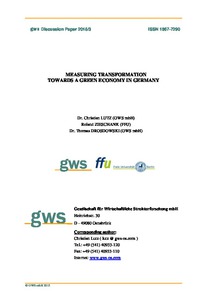Measuring transformation towards a green economy in Germany
"This paper reports results of the study „Green economy: Measuring sustainable welfare using SEEA data“. It contributes to measuring the progress towards green economy and its understanding for political decision making process in Germany. The definition of green economy follows the BMU approac...
| Main Authors: | , , , |
|---|---|
| Institution: | ETUI-European Trade Union Institute |
| Format: | TEXT |
| Language: | English |
| Published: |
Osnabrück
2015
GWS |
| Subjects: | |
| Online Access: | https://www.labourline.org/KENTIKA-19113130124919313129-Measuring-transformation-towar.htm |
| Summary: | "This paper reports results of the study „Green economy: Measuring sustainable welfare using SEEA data“. It contributes to measuring the progress towards green economy and its understanding for political decision making process in Germany. The definition of green economy follows the BMU approach of 2012. The concept to measure the green economy consists of six different dimensions: (A) use of natural resources and environmental damages, (B) natural capital, (C) environmental quality of life, (D) green economy: economic dimension and fields of action, (E) policies: institutional framework and measures, and (F) background information on economic and social development. For each dimension the concept includes indicators that can be generated from available data and in part have characteristics of desirable indicators. The concept is tested for Germany using scenario analysis (PANTA RHEI model) with regard to the energy transition (‘Energiewende’). Many indicators improve despite some trade-offs such as increases in resource use." |
|---|---|
| Physical Description: | 26 p. Digital |

